Wenfu Wang
Audio-Thinker: Guiding Audio Language Model When and How to Think via Reinforcement Learning
Aug 12, 2025Abstract:Recent advancements in large language models, multimodal large language models, and large audio language models (LALMs) have significantly improved their reasoning capabilities through reinforcement learning with rule-based rewards. However, the explicit reasoning process has yet to show significant benefits for audio question answering, and effectively leveraging deep reasoning remains an open challenge, with LALMs still falling short of human-level auditory-language reasoning. To address these limitations, we propose Audio-Thinker, a reinforcement learning framework designed to enhance the reasoning capabilities of LALMs, with a focus on improving adaptability, consistency, and effectiveness. Our approach introduces an adaptive think accuracy reward, enabling the model to adjust its reasoning strategies based on task complexity dynamically. Furthermore, we incorporate an external reward model to evaluate the overall consistency and quality of the reasoning process, complemented by think-based rewards that help the model distinguish between valid and flawed reasoning paths during training. Experimental results demonstrate that our Audio-Thinker model outperforms existing reasoning-oriented LALMs across various benchmark tasks, exhibiting superior reasoning and generalization capabilities.
Towards Open-set Camera 3D Object Detection
Jun 25, 2024Abstract:Traditional camera 3D object detectors are typically trained to recognize a predefined set of known object classes. In real-world scenarios, these detectors may encounter unknown objects outside the training categories and fail to identify them correctly. To address this gap, we present OS-Det3D (Open-set Camera 3D Object Detection), a two-stage training framework enhancing the ability of camera 3D detectors to identify both known and unknown objects. The framework involves our proposed 3D Object Discovery Network (ODN3D), which is specifically trained using geometric cues such as the location and scale of 3D boxes to discover general 3D objects. ODN3D is trained in a class-agnostic manner, and the provided 3D object region proposals inherently come with data noise. To boost accuracy in identifying unknown objects, we introduce a Joint Objectness Selection (JOS) module. JOS selects the pseudo ground truth for unknown objects from the 3D object region proposals of ODN3D by combining the ODN3D objectness and camera feature attention objectness. Experiments on the nuScenes and KITTI datasets demonstrate the effectiveness of our framework in enabling camera 3D detectors to successfully identify unknown objects while also improving their performance on known objects.
DSNet for Real-Time Driving Scene Semantic Segmentation
Dec 06, 2018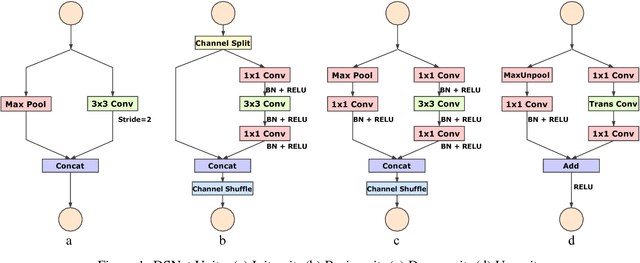
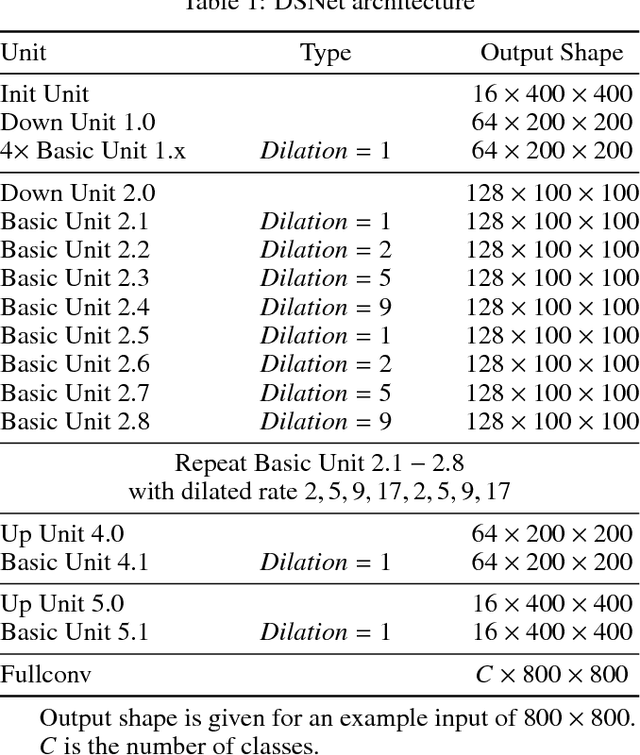
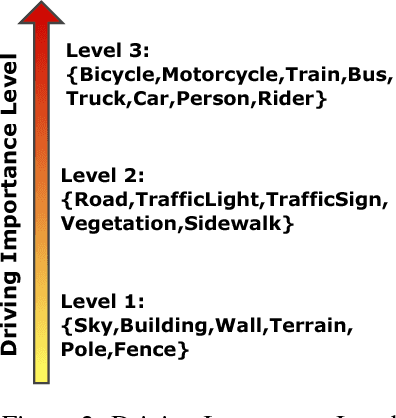
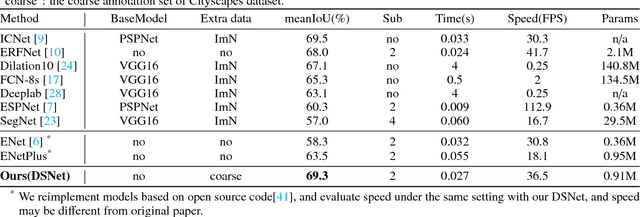
Abstract:We focus on the very challenging task of semantic segmentation for autonomous driving system. It must deliver decent semantic segmentation result for traffic critical objects real-time. In this paper, we propose a very efficient yet powerful deep neural network for driving scene semantic segmentation termed as Driving Segmentation Network (DSNet). DSNet achieves state-of-the-art balance between accuracy and inference speed through efficient units and architecture design inspired by ShuffleNet V2 and ENet. More importantly, DSNet highlights classes most critical with driving decision making through our novel Driving Importance-weighted Loss. We evaluate DSNet on Cityscapes dataset, our DSNet achieves 71.8% mean Intersection-over-Union (IoU) on validation set and 69.3% on test set. Class-wise IoU scores show that Driving Importance-weighted Loss could improve most driving critical classes by a large margin. Compared with ENet, DSNet is 18.9% more accurate and 1.1+ times faster which implies great potential for autonomous driving application.
A Scoring Method for Driving Safety Credit Using Trajectory Data
Nov 28, 2018
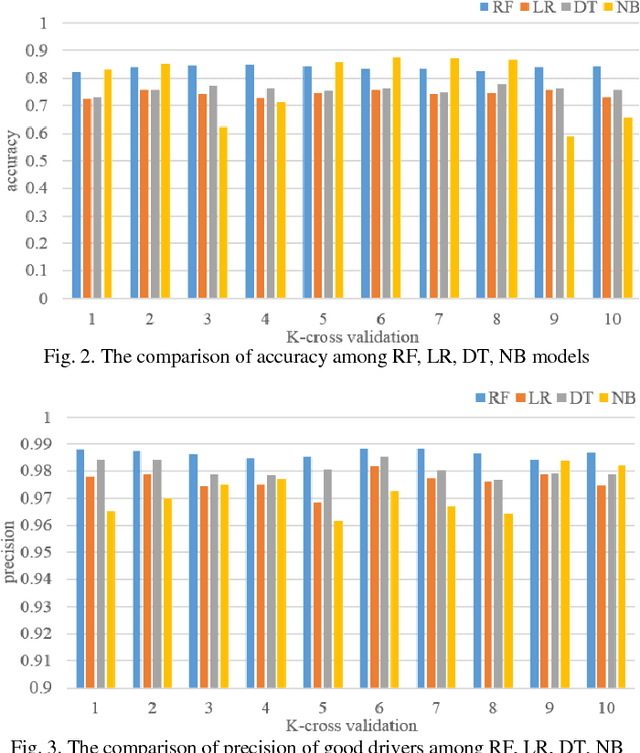
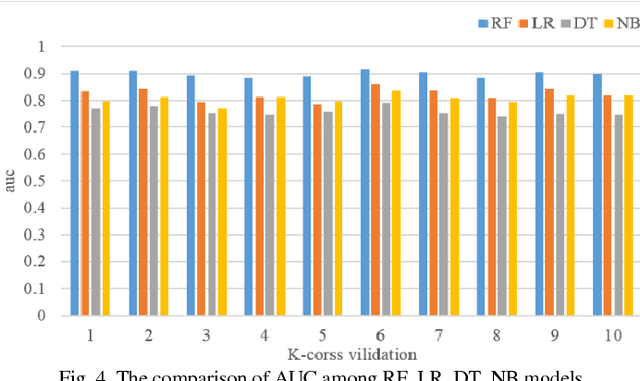
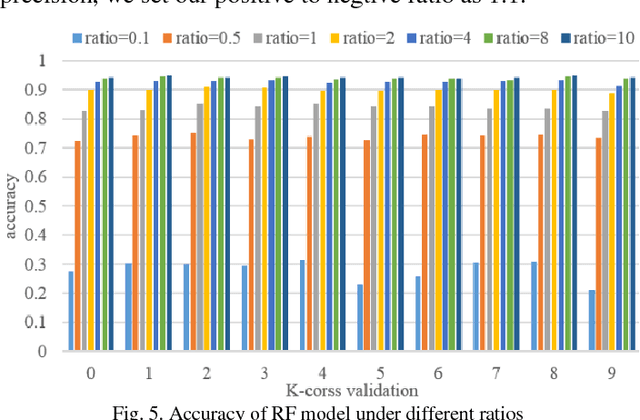
Abstract:Urban traffic systems worldwide are suffering from severe traffic safety problems. Traffic safety is affected by many complex factors, and heavily related to all drivers' behaviors involved in traffic system. Drivers with aggressive driving behaviors increase the risk of traffic accidents. In order to manage the safety level of traffic system, we propose Driving Safety Credit inspired by credit score in financial security field, and design a scoring method using trajectory data and violation records. First, we extract driving habits, aggressive driving behaviors and traffic violation behaviors from driver's trajectories and traffic violation records. Next, we train a classification model to filtered out irrelevant features. And at last, we score each driver with selected features. We verify our proposed scoring method using 40 days of traffic simulation, and proves the effectiveness of our scoring method.
 Add to Chrome
Add to Chrome Add to Firefox
Add to Firefox Add to Edge
Add to Edge